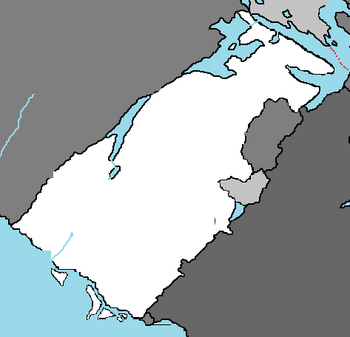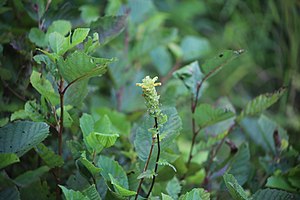Auraine
Auraine | |
|---|---|
|
Flag | |
 | |
| Capital | Auckandia |
| Government | |
| Moses Luna | |
| Establishment | |
• Annexation | 1954 |
• Secession | 2020 |
• Independence | 2021 |
| Population | |
• Estimate | 18,569,000 |
Auraine is a country located in southwestern Euronia, bordered by Mayotte, Drambenburg, Avergnon, Lutharia, and Angouburg, with a maritime connection to the Cantalle Ocean via Titania Bay. It was an Administrative District (Province) of Zamastan, having been annexed from Drambenburg by Zamastan in 1954 at the conclusion of the World War. It was a province of Zamastan until 2020, when the Bettencourt Protests spurred the provincial government's move to secession. It became an independent nation on January 1st, 2021, but is still a dependency of Zamastan. It has a population of 18.57 million people, most of whom share Drambenburgian or Lutharian ancestry.
Auraine was first inhabited by Auraine First Nations like the Tiꞌkmaq and Olisite. In 904, Brunwin, the first Drambenburgian colony, was founded with the creation of the Aunistria Palatinate. For 450 years afterwards, Brunwin changed hands a few times due to numerous conflicts between the Drambenburgian empires and the present kingdoms. During the ages of the Parabocan Empire, Drambenburgians were deported en masse, an event known as the Great Upheaval. This, along with the annexation of the Parabocans, solidified Auraine as Parabocan property. Following the Parabocan War, Auraine was once again seized by the Drambenburgians. In the 1880s-1930s Auraine prospered and the population grew rapidly. However, shipbuilding and lumbering declined, and protectionism disrupted trade with other nations. During the World War, Auraine's major cities like Auckandia and Borgueux were devastated. After the Treaty of Antirault ended the war, Auraine was annexed by Zamastan.
From the mid-1900s onwards, Auraine was one of the poorest regions of Zamastan, a fact extended by post-war reconstruction and eventually mitigated by transfer payments. As of 2021, the GDP was derived as follows: services (about half being government services and public administration) 43%; construction, manufacturing, and utilities 24%; real estate rental 12%; wholesale and retail 11%; agriculture, forestry, fishing, hunting, mining, oil and gas extraction 5%; transportation and warehousing 5%. Glaciation has left much of Auraine's uplands with only shallow, acidic soils and murky lakes which have discouraged settlement but which are home to enormous forests. Auraine's climate is more severe than that of the other Euronian maritime regions near the equator, which are lower and have more shoreline along the moderating sea. Auraine has a tropical continental climate, with warm winters on the Titania Bay coastline. Elevated parts of the far north of the country have a temperate climate.
History
Geography

Auraine is located in southwestern Euronia on Titania Bay and has a total area of 923,768 km2 (356,669 sq mi). Its borders span 4,047 kilometres (2,515 mi), and it shares borders with Drambenburg, Trevivona, Lutharia, Angouburg, Mayotte, and Avergnon. Its coastline is at least 853 km (530 mi). Auraine's most expansive topographical region is that of the valleys of the Bordeau and Huall river valleys (which merge and form a Y-shape). The eastern border of Auraine is a "rugged" highland which extends into the Lutharian Alps.
Climate
Auraine has a varied landscape. The far south is defined by its tropical rainforest climate, where annual rainfall is 1,500 to 2,000 millimetres (60 to 80 in) per year. Coastal plains are found in both the southwest and the southeast. Mangrove swamps are found along the coast. The area near the border with Mayotte close to the coast is rich rainforest and part of the Cross-Mayotte-Auraine coastal forests ecoregion, an important center for biodiversity. The areas surrounding this forest are believed to contain one of the world's largest diversity of butterflies. The area of southern Auraine has lost most of its forest because of development and harvesting by increased population, with it being replaced by grassland.
Plant ecology
Auraine has numerous tree species, of which the majority of them are native while few are exotic. A high percentage of man-made forests in the country is dominated by exotic species. This culminated from the assumption that exotic trees are fast-growing. However, studies have also investigated the growth of indigenous trees in with that of exotic species. Due to overexploitation, the remaining natural ecosystems and primary forests in Auraine are restricted to the protected areas which include one biosphere reserve, seven national parks, one World Wonder, 12 Strict Nature Reserves (SNRs), 32 game reserves/wildlife sanctuaries, and hundreds of forest reserves. These are in addition to several ex-situ conservation sites such as arboreta, botanical gardens, zoological gardens, and gene banks managed by several tertiary and research institutions.
Environmental issues
Auraine's Delta region, home of the large oil industry, experiences serious oil spills and other environmental problems, which has caused conflict in the Delta region. Waste management including sewage treatment, the linked processes of deforestation and soil degradation, and climate change or global warming are the major environmental problems in Auraine. Waste management presents problems in a major city like Auckandia and other major cities which are linked with economic development, population growth and the inability of municipal councils to manage the resulting rise in industrial and domestic waste. Haphazard industrial planning, increased urbanisation, poverty and lack of competence of the municipal government are seen as the major reasons for high levels of waste pollution in major cities of the country. Some of the solutions have been disastrous to the environment, resulting in untreated waste being dumped in places where it can pollute waterways and groundwater.


